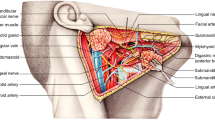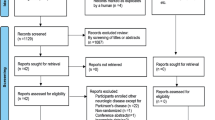Abstract
Rationale
Severe sialorrhea is a common, potentially stigmatizing and disabling side-effect of neuroleptic drugs such as clozapine. Sialorrhea also occurs in neurological disorders such as Parkinson's disease (PD). For neurological diseases, several studies have demonstrated botulinum toxin type B to be a safe and effective treatment.
Objectives
To evaluate the treatment effects, tolerance, and duration of treatment-induced effects of botulinum toxin type B (Neurobloc®) in the context of neuroleptic-induced sialorrhea (group 1) or PD-associated drooling (group 2) in a double-blind, placebo-controlled trial.
Methods
Nine patients (four from group 1; five from group 2) with severe sialorrhea received injections into the salivary glands with either botulinum toxin type B or placebo and were followed over 16 weeks.
Results
We found large effect sizes for improvement of sialorrhea in patients treated with botulinum toxin type B, whereas the improvement of sialorrhea in those receiving placebo was only small. No patient reported any side effects. Reduction of sialorrhea lasted for 8 to 16 weeks after a single injection.
Conclusions
Like for PD, botulinum toxin type B represents an effective and safe treatment for neuroleptic-induced sialorrhea with a treatment effect of 8 to 16 weeks.

Similar content being viewed by others
References
Antonello C, Tessier P (1999) Clozapine and sialorrhea: a new intervention for this bothersome and potentially dangerous side effect. J Psychiatry Neurosci 24:250
Bai YM, Lin CC, Chen JY, Liu WC (2001) Therapeutic effect of pirenzepine for clozapine-induced hypersalivation: a randomized, double-blind, placebo-controlled, cross-over study. J Clin Psychopharmacol 21:608–611
Bateson MC, Gibberd FB, Wilson RS (1973) Salivary symptoms in Parkinson disease. Arch Neurol 29:274–275
Ben-Aryeh H, Jungerman T, Szargel R, Klein E, Laufer D (1996) Salivary flow-rate and composition in schizophrenic patients on clozapine: subjective reports and laboratory data. Biol Psychiatry 39:946–949
Brodtkorb E, Wyzocka-Bakowska MM, Lillevold PE, Sandvik L, Saunte C, Hestnes A (1988) Transdermal scopolamine in drooling. J Ment Defic Res 32(Pt 3):233–237
Calderon J, Rubin E, Sobota WL (2000) Potential use of ipatropium bromide for the treatment of clozapine-induced hypersalivation: a preliminary report. Int Clin Psychopharmacol 15:49–52
Cohen J (1988) Statistical power analysis for the behavioral sciences. Lawrence Earlbaum Associates, Hillsdale
Copp PJ, Lament R, Tennent TG (1991) Amitriptyline in clozapine-induced sialorrhoea. Br J Psychiatry 159:166
Crysdale WS, White A (1989) Submandibular duct relocation for drooling: a 10-year experience with 194 patients. Otolaryngol Head Neck Surg 101:87–92
Davydov L, Botts SR (2000) Clozapine-induced hypersalivation. Ann Pharmacother 34:662–665
Eadie MJ, Tyrer JH (1965) Alimentary disorder in Parkinsonism. Australas Ann Med 14:13–22
Ellies M, Laskawi R, Gotz W, Arglebe C, Tormahlen G (1999) Immunohistochemical and morphometric investigations of the influence of botulinum toxin on the submandibular gland of the rat. Eur Arch Otorhinolaryngol 256:148–152
Ellies M, Laskawi R, Rohrbach-Volland S, Rodel R, Beuche W (2001) Blocking secretion of exocrine glands in the head-neck area by administration of botulinum toxin A. Therapy of a rare disease picture. HNO 49:807–813
Ellies M, Laskawi R, Rohrbach-Volland S, Arglebe C, Beuche W (2002) Botulinum toxin to reduce saliva flow: selected indications for ultrasound-guided toxin application into salivary glands. Laryngoscope 112:82–86
Fuster Torres MA, Berini Aytes L, Gay Escoda C (2007) Salivary gland application of botulinum toxin for the treatment of sialorrhea. Med Oral Patol Oral Cir Bucal 12:E511–E517
Gibb WR, Lees AJ (1988) The relevance of the Lewy body to the pathogenesis of idiopathic Parkinson's disease. J Neurol Neurosurg Psychiatry 51:745–752
Giess R, Naumann M, Werner E, Riemann R, Beck M, Puls I, Reiners C, Toyka KV (2000) Injections of botulinum toxin A into the salivary glands improve sialorrhoea in amyotrophic lateral sclerosis. J Neurol Neurosurg Psychiatry 69:121–123
Grabowski J (1992) Clonidine treatment of clozapine-induced hypersalivation. J Clin Psychopharmacol 12:69–70
Jackson CE, Gronseth G, Rosenfeld J, Barohn RJ, Dubinsky R, Simpson CB, McVey A, Kittrell PP, King R, Herbelin L, Muscle Study Group (2009) Randomized double-blind study of botulinum toxin type B for sialorrhea in ALS patients. Muscle Nerve 39:137–143
Kahl KG, Hagenah J, Zapf S, Trillenberg P, Klein C, Lencer R (2004) Botulinum toxin as an effective treatment of clozapine-induced hypersalivation. Psychopharmacology (Berl) 173:229–230
Kahl KG, Trillenberg P, Kordon A, Lencer R, Klein C, Hagenah J (2005) Pharmacological strategies for clozapine-induced hypersalivation: treatment with botulinum toxin B in one patient and review of the literature. Nervenarzt 76:205–208
Klingberg S, Schneider S, Wittorf A, Buchkremer G, Wiedemann G (2008) Collaboration in outpatient antipsychotic drug treatment: analysis of potentially influencing factors. Psychiatry Res 161:225–234
Lagalla G, Millevolte M, Capecci M, Provinciali L, Ceravolo MG (2009) Long-lasting benefits of botulinum toxin type B in Parkinson's disease-related drooling. J Neurol 256:563–567
Lipp A, Trottenberg T, Schink T, Kupsch A, Arnold G (2003) A randomized trial of botulinum toxin A for treatment of drooling. Neurology 61:1279–1281
Mancini F, Zangaglia R, Cristina S, Sommaruga MG, Martignoni E, Nappi G, Pacchetti C (2003) Double-blind, placebo-controlled study to evaluate the efficacy and safety of botulinum toxin type A in the treatment of drooling in Parkinsonism. Mov Disord 18:685–688
McEvoy JP, Lieberman JA, Stroup TS, Davis SM, Meltzer HY, Rosenheck RA, Swartz MS, Perkins DO, Keefe RS, Davis CE, Severe J, Hsiao JK, CATIE Investigators (2006) Effectiveness of clozapine versus olanzapine, quetiapine, and risperidone in patients with chronic schizophrenia who did not respond to prior atypical antipsychotic treatment. Am J Psychiatry 163:600–610
Ondo WG, Hunter C, Moore W (2004) A double-blind placebo-controlled trial of botulinum toxin B for sialorrhea in Parkinson's disease. Neurology 62:37–40
Pal PK, Calne DB, Calne S, Tsui JK (2000) Botulinum toxin A as treatment for drooling saliva in PD. Neurology 54:244–247
Porta M, Gamba M, Bertacchi G, Vaj P (2001) Treatment of sialorrhoea with ultrasound guided botulinum toxin type A injection in patients with neurological disorders. J Neurol Neurosurg Psychiatry 70:538–540
Rapp D (1980) Drool control: long-term follow-up. Dev Med Child Neurol 22:448–453
Rogers DP, Shramko JK (2000) Therapeutic options in the treatment of clozapine-induced sialorrhea. Pharmacotherapy 20:1092–1095
Sockalingam S, Shammi C, Remington G (2007) Clozapine-induced hypersalivation: a review of treatment strategies. Can J Psychiatry 52:377–384
Acknowledgments
This work was supported by intramural grants from the Medical Faculty, University of Luebeck to S.S. C.K. is funded by the Volkswagen Foundation and the Hermann and Lilly Schilling Foundation.
Author information
Authors and Affiliations
Corresponding author
Rights and permissions
About this article
Cite this article
Steinlechner, S., Klein, C., Moser, A. et al. Botulinum toxin B as an effective and safe treatment for neuroleptic-induced sialorrhea. Psychopharmacology 207, 593–597 (2010). https://doi.org/10.1007/s00213-009-1689-y
Received:
Accepted:
Published:
Issue Date:
DOI: https://doi.org/10.1007/s00213-009-1689-y




